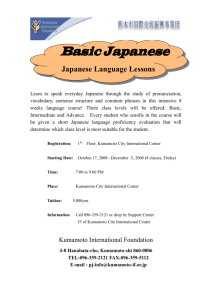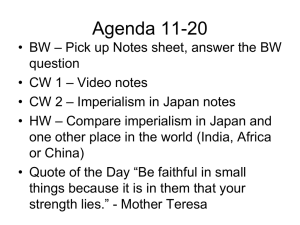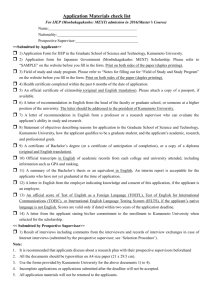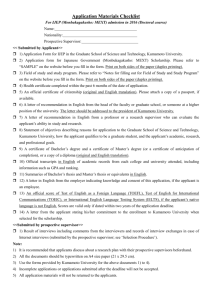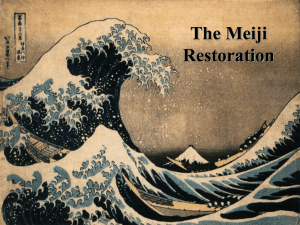handbook materials
advertisement
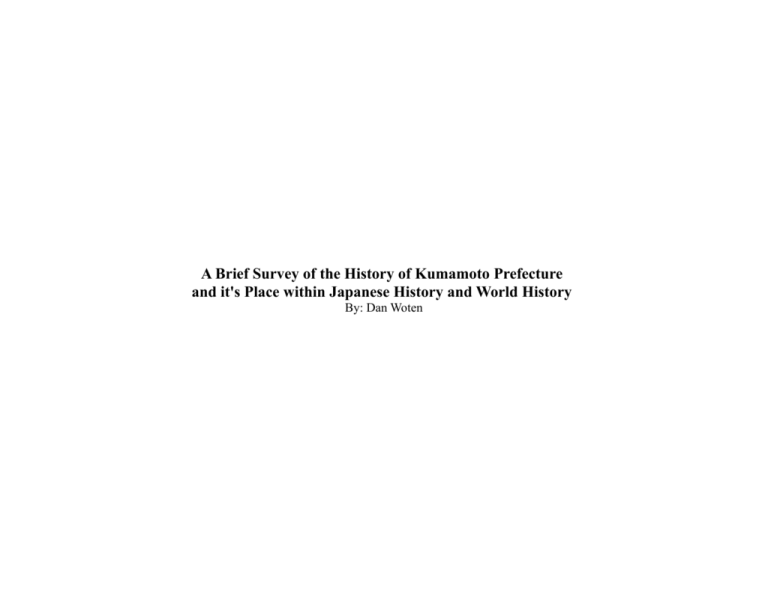
A Brief Survey of the History of Kumamoto Prefecture and it's Place within Japanese History and World History By: Dan Woten Year Period 300 BC Jōmon Kumamoto is estimated to contain Japan's earliest settlements. Hunters, fishers, and gatherers are prevalent in Japan during this period. Construction of the Great Pyramid of Cholula begins Yayoi 1/3 of Japan's archeological sites are in Kumamoto Prefecture Introduction of rice and, with it, social hierarchy Height of the Roman Empire 300B300 300538 538710 Events in Kumamoto Events in Japan Hundreds of small countries begin to group together Jesus is born 300: Loose unification of Japan Kofun Asuka This period is characterized by Kofun, large tombs built for the deceased leaders Fall of the Western Roman Empire and the beginning of the Early Middle Ages 538-552: Buddhism is introduced to Japan Muhammad is born During this period, Kumamoto is known as 604: The Seventeen Article Constitution (十七条憲 Augustine arrives in Kent Higo Province and is the only major 法 jūshichijō kenpō ) is authored by Prince i province on Kyushu. Shōtoku The Tang Dynasty is 645: Introduction of the Taika Reformii 710794 710: Nara is chosen as the first Capital Nara 784: Capital is moved to Nagaoka At the beginning of the Heian period, Higo Province contains 14 counties and 99 villages. 7941185 Heian Events in the World 794: The capital is moved to Heian (Kyōto) 1159: Fujiwara Michinaga is named regent 1159: Taira Kiyomori leads the Taira clan to power at the close of the Heiji War The Aso clan and the Kikuchi clan hold the 1175: Introduction of the Jodo sect of Buddhism majority of power in Higo and, from the 11th century, these clans possess armies of their 1180-85: The Gempei War: the Minamoto claniiirises to power with the defeat of the Taira clan own. Both clans ally themselves with the Taira clan. 1191: Introduction of the Zen sect of Buddhism established in China Rise of the Abbasid Caliphate Charlemagne becomes Holy Roman Emperor Vikings enter England Mayan Empire falls Song Dynasty begins in China William the Conqueror invades England First and Second Crusade After the Taira fall, the Kikuchi clan allies with the Kamakura Bakufu (government). 11921333 The Kikuchi clan plays a major role in defending Fukuoka against the Mongol Kamakura invasions. Due to this, the 12th head of the clan, Kikuchi Taketoki becomes one of the Emperor's most trusted generals. Takezake Suenaga, a prominent retainer of Higo Province, leaves behind extensive records of the Mongol invasion.iv Third and Fourth 1192: Minamoto Yoritomo is appointed Shōgun and Crusade the Kamakura government is created Rise of Mongol Empire 1221: The Jōkyū Disturbance ends a struggle between Kamakura and Kyoto resulting in the supremacy of the Hojo regents in Kamakura 1232: The Jōei Shikimoku (legal-code) is createdv 1274/1281: Two invasion attempts by the Mongol army fail due mainly to weather 1333: The Kamakura Bakufu fallsvi 1334: Kemmu Restoration: the emperor restores power over Japan The Kikuchi and Aso clans support the 1336: Ashikaga Takauji captures Kyoto Southern Court during the split. 1337: The emperor flees and establishes the Southern court in Yoshinoviii th Kikuchi Takeshige, 13 head of the Kikuchi 1338: Takauji establishes the Muromachi clan, creates a blood oath to unify his clan. government and a second emperor in Kyoto 1333Muromachi This is the country's oldest constitution (Northern court) 1573 signed in blood. The constitution can still be 1392: Unification of the Southern and Northern seen today at the Kikuchi Shrine. courts 1467-1477: Onin warix 1542: Portuguese introduce firearms and The Kikuchi clan falls from power during Christianity to Japan the Sengoku Periodvii. 1568: Nobunaga enters Kyotox 1573: The Muromachi Bakufu falls Reconquista in Spain Magna Carta is created First War of Scottish Independence Rise of Ottoman Empire Knights Templar fall Dante publishes his Divine Comedy England and France enter the Hundred Years War The Black Death kills up to half of Europe's population The Bible is translated into English Johannes Gutenburg invents the printing press Constantinople falls to the Ottoman Empire Christopher Columbus sails to the “New World” Martin Luther writes his 95 Theses Toyotomi Hideyoshi invades Kyushu and grants Higo Province to Sassa Narimasa. Sassa is unable to maintain order and is ordered to commit seppuku. Higo Province is then split between Katō Kiyamasa and Azuchi Yukinaga Konishi. In 1600, Yukinaga 15731603 Momoyama Konishi falls at Sekigahara and Katō Kiyamasa takes control of Higo Province. Katō is later responsible for developing Kumamoto City and Kumamoto Castle. Christianity begins to flourish in Amakusa. 1575: The Takeda clan is defeated in the battle of Nagashino 1582: Nobunaga is murdered by his general, succeeded by Toyotomi Hideyoshixi 1588: Hideyoshi confiscates the weapons of farmers and religious institutions in the "Sword Hunt" 1592-98: Korea Campaign 1598: Death of Hideyoshi 1600: Tokugawa Ieyasu defeats his rivals in the battle of Sekigaharaxii Suizenji Park is created in 1634. 16031867 In 1637, 15 year old Amakusa Shiro leads 30,000 Christian peasants in a rebellion against high taxes in the Shimabara region. The rebellion is crushed and subsequently plays a factor in the coming persecution of Christians. Edo Mt. Unzen's eruption in 1792 causes 2 major earthquakes and a tsunami, claiming 15,000 lives. The early 19th century sees hot springs constructed around Aso and also the construction of Japan's largest aqueduct, the Tsujun Bridge. Copernicus publishes his theory that the universe revolves around the Sun Pope Gregory XIII issues the Gregorian Calendar Colony at Roanoke established in North America England defeats the Spanish Armada Colony established at Jamestown, Virginia Mayflower arrives in North America 1603: Ieyasu is appointed shogun and establishes the Tokugawa Shogunate in Edo (Tokyo) 1614: Ieyasu intensifies persecution of Christianity 1615: The Toyotomi clan is destroyed after Ieyasu captures Osaka Castle 1639: Almost complete isolation of Japan from the rest of the worldxiii 1854: Commodore Matthew C. Perry forces the Japanese government to open a limited number of ports for tradexiv Charles I executed in England Manchu conquer China Taj Mahal is completed War of American Independence Scottish Engineer James Watt builds an improved steam engine Qajar Dynasty founded in Iran Napoleon seizes power Karl Marx publishes Das Kapital The Suez Canal opens With the Meiji Restoration, all lands are returned to the Emperor in 1869. At this time, Higo Province becomes Kumamoto Prefecture. 18681912 19121926 19261989 1989Present Meiji 1868: Meiji restorationxv Kumamoto Medical School and the Kumamoto School of Western Studies open. 1872: First railway line between Tokyo and Yokohama Angry Samurai, stripped of their positions, 1889: The Meiji Constitution is created lead a number of rebellions against the 1894-95: Sino-Japanese War Meiji government. The last of these is the 1904-05: Russo-Japanese War Satsuma Rebellion (1877). The first major 1910: Annexation of Korea battle of the Satsuma Rebellion is an attack 1912: Death of emperor Meiji and siege on Kumamoto Castle. The siege is eventually defeated by the Imperial Army. Kumamoto Castle becomes a major headquarters for the Imperial Army. Taisho There is widespread prosperity and 1914-18: Japan enters WW1 development within Kumamoto until World 1923: The Great Kanto Earthquake devastates War II. Tokyo and Yokohama Showa In 1931, Emperor Hirohito himself oversees a massive military exercise at Kumamoto 1931: Manchurian Incident Castle. 1937: Second Sino-Japanese War begins During WWII, Kumamoto City is the target 1941: Japan enters World War II of two major airstrikes. Approximately one- 1945: Japan surrenders after two atomic bombs are dropped over Hiroshima and Nagasaki third of the city is destroyed. 1946: The new constitution is created Mt. Aso erupts in 1953. Also, northern 1952: The Allied Occupation of Japan ends Kyushu is ravaged by flooding. 1956: Japan becomes member of the UN 1972: Normalization of relations to China Kumamoto Castle undergoes extensive repairs in 1960. Heisei Kumamoto Prefecture has a population of 1.8 million people (ranked 23rd in Japan) 1995: Sarin Gas attack in the Tokyo subway by AUM sect 2011: Great Eastern Japan Earthquake Franco-Prussian War ends with unification of both Germany and Italy Thomas Edison tests his first light bulb Louis Pasteur creates a vaccine for anthrax Tsar Alexander II is assassinated Olympics revived in Athens Spanish-American War Boxer Rebellion Archduke Francis Ferdinand is assassinated, triggering World War I Germany invades Poland, triggering World War II The United Nations creates Israel Jack St. Clair Kilby invents the microchip Neil Armstrong lands on the moon Chernobyl disaster i The Seventeen Article Constitution outlined Buddhist and Confucian morals and guidelines that government officials and subjects of the Emperor needed to follow in order to ensure a stable state. ii The Taika Reforms were extensive reforms that restructured land, government, and social structures so that they resembled the structures existent in China at the time. iii The Gempei War was the culmination of tensions between the Minamoto and Taira clans over influence in the Imperial Court. Tensions turned to conflict with a disagreement over a successor to the throne. iv Takezaki Suenaga was a prominent retainer of Higo Province. He played an important role in the defense of Fukuoka. After the battles, Takezaki sold his horses and saddles to finance a trip to Kamakura in order to report his deeds and receive his rewards. Takezaki later commissioned the Moko Shurai Ekotoba, a painting that depicts these reported deeds. v Before the Jōkyū Disturbance, the bakufu ruled on court cases without written law or precedent. After the disturbance, the courts were flooded with land disputes and the Jōei Shikimoku was created as a standard to decide these disputes. vi Largely due to Ashikaga Takauji switching sides in the middle of battle, Emperor Go-Daigo was able to return from exile and reclaim the Imperial throne. Ashikaga Takauji was named Shōgun as a reward. vii The Sengoku Period was a span of nearly one hundred and fifty years of social upheaval and nearly constant military conflict. This period is famous for gekokujō, or the conquering of the higher class by the lower class. viii After assuming power, Ashikaga Takauji disagreed with Emperor Go-Daigo on the methods to rule. To solve this dispute, Ashikaga replaced the Emperor with one of the Emperor's heirs. Fearing for his life, Go-Daigo then fled to Yoshino and set-up his court there. This split between the Northern and Southern Courts continued until the Southern Court eventually surrendered. ix The Ōnin War began as a dispute between Hosokawa Katsumoto and Yamana Sōzen. The dispute eventually escalated into a nationwide war that resulted in the majority destruction of the city of Kyoto and the beginning of the Sengoku Period. x Oda Nobunaga was the first of the Three Unifiers of Japan (followed by Toyotomi Hideyoshi and Tokugawa Ieyasu). Nobunaga was able to unify only a third of the country before he was murdered by one of his generals. His loyal follower, Toyotomi Hideyoshi, continued his conquest. xi Toyotomi Hideyoshi was the second of the Three Unifiers of Japan. He was also the first man to completely unify the country. He was responsible for bringing the Sengoku Period to an end and rebuilding much of the country. Hideyoshi is famous for his decree that only the samurai class could carry swords and for his crucifixion of twenty-six Christians in Nagasaki. Upon his death, his young son would be displaced by Tokugawa Ieyasu. xii With the defeat of his rival contenders at the Battle of Sekigahara, Tokugawa Ieyasu rose to power and founded the Tokugawa Shogunate. The Tokugawa Shogunate would rule from 1603 until the Meiji Restoration in 1868. The country during this period was relatively peaceful, with culture and commerce flourishing. xiii The Closed Country Edict of 1635 prohibited any Japanese to leave Japan and, if they did leave, banned them from returning on penalty of death. The edict also restricted foreigners to land only on an artificial island in Nagasaki Harbor and, later, a small quarter within Nagasaki. As Christianity was seen as a destabilizing force, especially after the Shimabara Rebellion, Christian daimyo (warlords) were forced to convert from Christianity. At this point, many Christians were forced to go “underground”, some of them hiding in Amakusa. xiv In 1854, Commodore Matthew C. Perry sailed a fleet of black ships into Edo Bay. After a show of force, the Japanese agreed to meet with Perry, and U.S. President Fillmore's trade agreement was eventually accepted. xv The Meiji Restoration was the return of Imperial rule to Japan under Emperor Meiji. The Restoration was a response to the sudden realization that Japan had been left behind in the world due to isolation, and could not compete with the advanced technologies of the Western world. The Meiji government brought about the modernization and industrialization of Japan at an astonishing speed.
